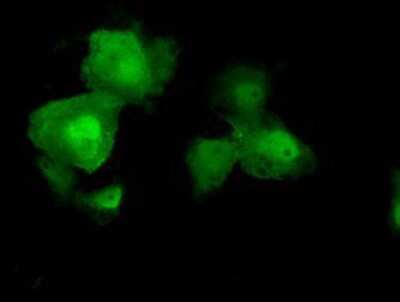AKT2 Antibody (OTI4H7)
Novus Biologicals, part of Bio-Techne | Catalog # NBP2-02231

![Western Blot: AKT2 Antibody (OTI4H7) [NBP2-02231] Western Blot: AKT2 Antibody (OTI4H7) [NBP2-02231]](https://resources.bio-techne.com/images/products/AKT2-Antibody-4H7-Western-Blot-NBP2-02231-img0003.jpg)
Conjugate
Catalog #
Forumulation
Catalog #
Key Product Details
Species Reactivity
Human, Mouse, Rat
Applications
Flow Cytometry, Immunocytochemistry/ Immunofluorescence, Immunohistochemistry, Immunohistochemistry-Paraffin, Western Blot
Label
Unconjugated
Antibody Source
Monoclonal Mouse IgG1 Clone # OTI4H7
Concentration
0.56 mg/ml
Product Specifications
Immunogen
Full length human recombinant protein of human AKT2 (NP_001617) produced in HEK293T cell.
Reactivity Notes
Please note that this antibody is reactive to Mouse and derived from the same host, Mouse. Mouse-On-Mouse blocking reagent may be needed for IHC and ICC experiments to reduce high background signal. You can find these reagents under catalog numbers PK-2200-NB and MP-2400-NB. Please contact Technical Support if you have any questions.
Clonality
Monoclonal
Host
Mouse
Isotype
IgG1
Theoretical MW
55.6 kDa.
Disclaimer note: The observed molecular weight of the protein may vary from the listed predicted molecular weight due to post translational modifications, post translation cleavages, relative charges, and other experimental factors.
Disclaimer note: The observed molecular weight of the protein may vary from the listed predicted molecular weight due to post translational modifications, post translation cleavages, relative charges, and other experimental factors.
Scientific Data Images for AKT2 Antibody (OTI4H7)
Western Blot: AKT2 Antibody (OTI4H7) [NBP2-02231]
Western Blot: AKT2 Antibody (4H7) [NBP2-02231] - HEK293T cells were transfected with the pCMV6-ENTRY control (Left lane) or pCMV6-ENTRY AKT2 (Right lane) cDNA for 48 hrs and lysed. Equivalent amounts of cell lysates (5 ug per lane) were separated by SDS-PAGE and immunoblotted with anti-AKT2.
Immunocytochemistry/Immunofluorescence: AKT2 Antibody (4H7) [NBP2-02231] Staining of COS7 cells transiently transfected by pCMV6-ENTRY AKT2.
Immunohistochemistry-Paraffin: AKT2 Antibody (OTI4H7) [NBP2-02231]
Immunohistochemistry-Paraffin: AKT2 Antibody (4H7) [NBP2-02231] - Staining of paraffin-embedded Human liver tissue using anti-AKT2 mouse monoclonal antibody.Applications for AKT2 Antibody (OTI4H7)
Application
Recommended Usage
Flow Cytometry
1:100
Immunocytochemistry/ Immunofluorescence
1:50-100
Immunohistochemistry
1:50
Immunohistochemistry-Paraffin
1:50
Western Blot
1:1000
Formulation, Preparation, and Storage
Purification
Immunogen affinity purified
Formulation
PBS (pH 7.3), 1.0% BSA and 50% Glycerol
Preservative
0.02% Sodium Azide
Concentration
0.56 mg/ml
Shipping
The product is shipped with polar packs. Upon receipt, store it immediately at the temperature recommended below.
Stability & Storage
Store at -20C. Avoid freeze-thaw cycles.
Background: Akt2
The main function of AKT is to control inhibition of apoptosis and promote cell proliferation. Survival factors can activate AKT Ser473 and Thr308 phosphorylation sites in a transcription-independent manner, resulting in the inactivation of apoptotic signaling transduction through the tumor suppressor PTEN, an antagonist to PI3-K (5). PTEN exerts enzymatic activity as a phosphatidylinositol-3,4,5-trisphosphate (PIP3) phosphatase, opposing PI3K activity by decreasing availability of PIP3 to proliferating cells, leading to overexpression and inappropriate activation of AKT noted in many types of cancer.
AKT1 function has been linked to overall physiological growth and function (2). AKT1 has been correlated with proteus syndrome, a rare disorder characterized by overgrowth of various tissues caused by a mosaic variant in the AKT1 gene in humans.
AKT2 is strongly correlated with Type II diabetes, including phenotypes of insulin resistance, hyperglycemia and atherosclerosis (2, 6).
The function of AKT3 is specifically associated to brain development, where disruptions to AKT3 are correlated with microcephaly, hemimegalencephaly, megalencephaly and intellectual disabilities (2).
References
1. Ersahin, T., Tuncbag, N., & Cetin-Atalay, R. (2015). The PI3K/AKT/mTOR interactive pathway. Mol Biosyst, 11(7), 1946-1954. doi:10.1039/c5mb00101c
2. Cohen, M. M., Jr. (2013). The AKT genes and their roles in various disorders. Am J Med Genet A, 161a(12), 2931-2937. doi:10.1002/ajmg.a.36101
3. Georgescu, M. M. (2010). PTEN Tumor Suppressor Network in PI3K-Akt Pathway Control. Genes Cancer, 1(12), 1170-1177. doi:10.1177/1947601911407325
4. Mishra, P., Paital, B., Jena, S., Swain, S. S., Kumar, S., Yadav, M. K., . . . Samanta, L. (2019). Possible activation of NRF2 by Vitamin E/Curcumin against altered thyroid hormone induced oxidative stress via NFkB/AKT/mTOR/KEAP1 signalling in rat heart. Sci Rep, 9(1), 7408. doi:10.1038/s41598-019-43320-5
5. Wedel, S., Hudak, L., Seibel, J. M., Juengel, E., Oppermann, E., Haferkamp, A., & Blaheta, R. A. (2011). Critical analysis of simultaneous blockage of histone deacetylase and multiple receptor tyrosine kinase in the treatment of prostate cancer. Prostate, 71(7), 722-735. doi:10.1002/pros.21288
6. Rotllan, N., Chamorro-Jorganes, A., Araldi, E., Wanschel, A. C., Aryal, B., Aranda, J. F., . . . Fernandez-Hernando, C. (2015). Hematopoietic Akt2 deficiency attenuates the progression of atherosclerosis. Faseb j, 29(2), 597-610. doi:10.1096/fj.14-262097
Long Name
v-Akt Murine Thymoma Viral Oncogene Homolog 2
Alternate Names
PKB beta, RAC-beta
Entrez Gene IDs
208 (Human)
Gene Symbol
AKT2
Additional Akt2 Products
Product Documents for AKT2 Antibody (OTI4H7)
Product Specific Notices for AKT2 Antibody (OTI4H7)
This product is for research use only and is not approved for use in humans or in clinical diagnosis. Primary Antibodies are guaranteed for 1 year from date of receipt.
Loading...
Loading...
Loading...
Loading...
Loading...

![Immunohistochemistry-Paraffin: AKT2 Antibody (OTI4H7) [NBP2-02231] Immunohistochemistry-Paraffin: AKT2 Antibody (OTI4H7) [NBP2-02231]](https://resources.bio-techne.com/images/products/AKT2-Antibody-4H7-Immunohistochemistry-Paraffin-NBP2-02231-img0006.jpg)
![Flow Cytometry: AKT2 Antibody (OTI4H7) [NBP2-02231] Flow Cytometry: AKT2 Antibody (OTI4H7) [NBP2-02231]](https://resources.bio-techne.com/images/products/AKT2-Antibody-4H7-Flow-Cytometry-NBP2-02231-img0002.jpg)
![Immunocytochemistry/ Immunofluorescence: AKT2 Antibody (OTI4H7) [NBP2-02231] Immunocytochemistry/ Immunofluorescence: AKT2 Antibody (OTI4H7) [NBP2-02231]](https://resources.bio-techne.com/images/products/AKT2-Antibody-4H7-Immunocytochemistry-Immunofluorescence-NBP2-02231-img0004.jpg)
![Immunohistochemistry-Paraffin: AKT2 Antibody (OTI4H7) [NBP2-02231] Immunohistochemistry-Paraffin: AKT2 Antibody (OTI4H7) [NBP2-02231]](https://resources.bio-techne.com/images/products/AKT2-Antibody-4H7-Immunohistochemistry-Paraffin-NBP2-02231-img0005.jpg)
![Flow Cytometry: AKT2 Antibody (OTI4H7) [NBP2-02231] Flow Cytometry: AKT2 Antibody (OTI4H7) [NBP2-02231]](https://resources.bio-techne.com/images/products/AKT2-Antibody-4H7-Flow-Cytometry-NBP2-02231-img0001.jpg)